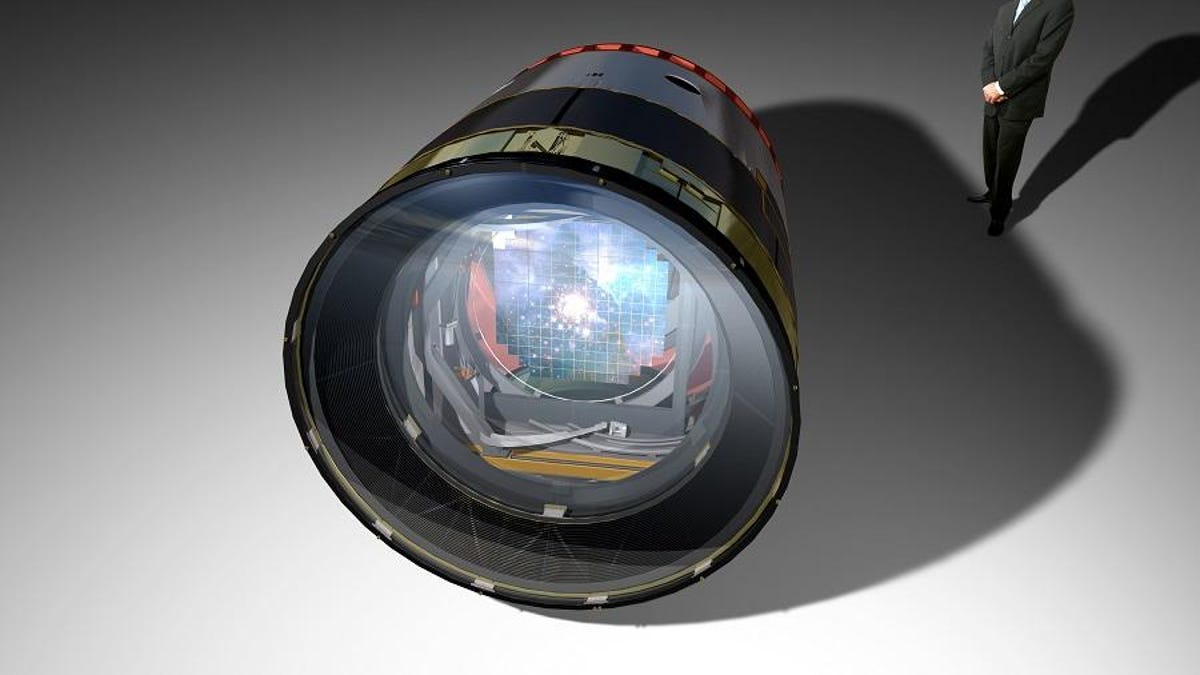Large Synoptic Survey Telescope: Photos of the world's biggest digital camera
The mammoth Large Synoptic Survey Telescope project takes a lot of scientists and engineers -- and brings a whole lot of megapixels.

Say cheese!
How do you capture the deepest, widest look yet into the universe? With the help of the 3.2-gigapixel Large Synoptic Survey Telescope (LSST) camera.
Currently under construction, and depicted here in this illustration, the LSST camera will be the biggest digital camera ever created. Its aperture will stand at nearly five and a half feet.
You've gotta see these pictures showing how it's all coming together...
Big eye
Here's a rendering of where the LSST camera's big eye will be put to work: At the summit of the Chilean mountain Cerro Pachón.
The telescope will be tasked with surveying 37 billion stars and galaxies over the course of a 10-year mission due to begin in 2021.
Sky's the limit
When completed, the LSST project will scan the southern sky, collecting 15TB of raw data each night, and ultimately shining new light on dark matter, dark energy and more.
Boom!
At the LSST's home base in Chile, mountain terrain needed to be evened out. This is a 2011 shot of a leveling blast on the Cerro Pachón's El Peñón summit.
Inside the 'scope
This illustration takes us inside, literally, the LSST complex. The world's biggest digital camera will be a major part of a mammoth operation that's engaging scientists worldwide.
Breaking it down
Here's an annotated look at all of the components of the LSST camera, under construction since 2015.
Putting the band together
To help read the sky in detail, the LSST camera will be equipped with a filter carousel, or wheel, depicted here.
Six filters will be available. Each filter will deal with a different spectral band.
MIrroring behavior
In 2008, the University of Arizona cast the LSST's 27.5-foot-diameter primary mirror from 51,900 pounds of glass.
The primary mirror, known as the M1M3, is actually two mirrors in one.
Let it shine
In 2012, the M1M3 mirror was polished and, as LSST put it, "nearing perfection."
Polish makes perfect
This is the M1M3 in its container in 2015 as polishing work was completed.
From the ground up
In 2016, concrete work was underway in Chile for the telescope mount assembly's permanent pier foundation.
Rebar for the test site
A few months later, rebar was laid out for a duplicate pier in Spain. This pier was to be used as a test site for the Chilean-bound telescope mount assembly.
Color coding for mirror
Seen in 2016, these are 24 color-coded components for the LSST's secondary mirror, the M2.
Power ring
This is the cell assembly for the 11-foot-five-inch-diameter M2, as seen suspended in its Rochester, NY, test tower in 2017.
Giant O-ring
Another, otherworldly view of the M2 cell assembly.
Chillin' the sensors
The LSST camera's cryostat rear support ring (seen here in 2017) will help keep the focal-plane sensors running at the optimal temperature: 100 degrees below Celsius.
The white-glove treatment
Here's a look at the LSST camera's clean room in Menlo Park during a test session.
No dust allowed
Here's another view of the clean room.
Under pressure
The factory at Spain's Astrufeito was humming in July 2017 as work continued on the telescope mount.
That's a wrap ... so to speak
This is a test session in Spain for the the telescope mount's cable wrap assembly.
There's no place like dome
In Chile in August 2017, a five-ton, 30-foot-diameter dome was installed atop the project's auxiliary telescope building.
Come together
In November 2017, another piece of the puzzle came together when the M1M3's surrogate mirror was mounted to its cell at CAID Industries in Tucson, Arizona.
Getting a lift
The LSST project is so big it needs a vertical lift platform to get the job done. This lift was installed at the Chile site in December 2017. It'll move the mirrors and camera, up and down, for maintenance.
Money from billionaires
In the works since the turn of the 21st century, the LSST project got a $10 million boost from Bill Gates in 2008.
The Microsoft founder was taken by plans to share the telescope's data with the public. "LSST is truly an internet telescope," he said.
On the horizon
This November 2017 shot of the LSST Observatory shows progress made, and a future still to come.

